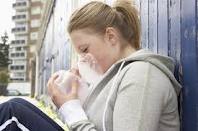Inhalants are chemical vapors from fairly common household products that users specifically abuse by inhaling them to produce a high that is similar to the effects of consuming too much alcohol. Known by users as whippets, poppers, or snappers, the mind-altering effect of the drug can cause very serious bodily harm to abusers.
Irreversible Effects of Inhalants

Inhalants
Nearly all solvents or gasses that can be inhaled cause loss of sensation and can even produce unconsciousness. The irreversible inhalant dangers and effects of chemical vapors include hearing loss, brain damage, bone marrow loss, and damage to the central nervous system.
These harmful reactions occur because of the oxygen levels that are displaced in the lungs while inhaling the harmful chemicals and deprive the brain of oxygen, the same reason a high is being felt. This is a condition known as hypoxia, and is extremely damaging to cells throughout the body. Among the more harmful effects of inhalants are loss of memory, the ability to put thoughts in order, and carry even simple conversations may also occur.
Long-Term Effects
Nerve fibers in the body have a natural fatty tissue that surrounds and protects them, but in long term inhalant abusers this fatty tissue becomes severely damaged leaving the nerves exposed. This causes the nerves to be unable to send and receive signals efficiently throughout the body resulting in muscle spasms, tremors, difficulty walking, bending, or even talking.
Inhalants not only cause physical complications, but can be extremely lethal. It is very difficult to control the amount of chemical vapors that are inhaled, and even an otherwise healthy individual who is a first time user can induce heart failure and death within minutes of a session that this drug of abuse is inhaled because of the swelling that is caused in the blood vessels during inhalation.
Although not directly connected to inhalants in and of themselves, HIV and STD rates statistically are higher in inhalant abusers. Because of the mind-altering ability of the drug, it is associated with enhancing sexual experiences and is related to unsafe sexual practices and increased risks of blood-borne illnesses such as HIV/AIDS and Hepatitis.
Children and Inhalant Abuse
Because of the commonality of the types of inhalants that are abused, such as spray paint, glue, gasoline, and household cleaners the rate of abuse is higher among adolescents between ages 12-18, with 8th graders holding the highest percentage of abusers. A 2002-2008 study done by National Survey on Drug use and Health showed that of the 720,000 adolescents who reported abusing inhalants, 67% were under the age of 17. With the staggering number of young people engaging in this dangerous activity, it is extremely important that parents be aware of the risks and take steps to communicate with their children about inhalant abuse, and keep a watchful eye on products used as inhalants.
Early Signs of Abuse
Early identification of inhalant abuse is key to helping put a stop to the abuse before it causes serious health consequences or even death. Knowing the sings of inhalant abuse can help family and friends of abusers intervene, especially those who are responsible for young people, parents, doctors, teachers, and family members.
Early signs of abuse include :
- Chemical odors on breath, hair, or clothing
- Slurred speech
- Paint stains on the face, neck, or arms
- Disoriented behavior
- Hidden spray paint cans, aerosols, or chemical soaked rags
- Nausea or lack of appetite
- Lack of coordination
- Irritability and depression
The high caused by inhalants only lasts for a few minutes and usually causes repeated use and inhalant addiction. Studies show that children who experiment with inhalants are far more likely to abuse a variety of drugs in the future. Being educated on inhalants and offering support and guidance can save young people from a lifetime of drug abuse.
If a person you know is abusing inhalants, seeking professional help and support is necessary to stopping them before the damage becomes irreversible or life threatening.
